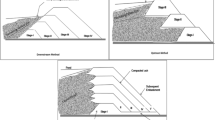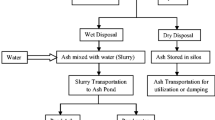Abstract
We investigated potential contamination of surface and ground water due to placement of fly ash in an abandoned area of an active opencast mine. Leachates from the fly ash and pond ash did not exceed the effluent discharge limits for inland surface water. Even though iron was one of the major components of the ash, it did not exceed 0.3 mg/L in the leachates. Water quality studies carried out at the coal mine indicated that fly ash disposal there, was not affecting the groundwater, but that the water discharged from the active portion of the mine contained high concentrations of total hardness, total dissolved solids (TDS), sulphate, manganese, and iron, exceeding India’s effluent discharge limits. The nearby Ajay River was not contaminated but the confluence point where the mine water met the Ajay River contained high levels of TDS, sulphate, and manganese. Groundwater in the area surrounding the mine was not significantly impacted. Multivariate statistical analysis was carried out to determine the relationships between the different water quality parameters.
Zusammenfassung
In dieser Studie wird die mögliche Belastung von Oberflächen- und Grundwasser durch die Einlagerung von Flugasche in einen abgeworfenen Teilbereich eines aktiven Tagebaus untersucht. Die Sickerwassergehalte aus der Flugasche bzw. der Asche aus Absatzbecken übersteigen nicht die Grenzwerte für Abwassereinleitungen in Oberflächengewässer. Obwohl Eisen die Hauptkomponente der Asche darstellt, weisen die Konzentrationen im Sickerwasser Werte unter 0.3 mg/L auf. Studien über die Wasserqualität des Kohlebergbaus zeigen, dass die Ascheablagerungen die Grundwasserqualität nicht beeinflussen. Jedoch weisen Abwässer des aktiven Bergbauteils hohe Konzentrationen an Härtebildnern, Gesamtkonzentrationen (TDS), Sulfat, Mangan und Eisen auf, welche die indischen Abwassergrenzwerte übersteigen. Der nahe gelegene Vorfluter Ajay ist zwar nicht betroffen, jedoch werden am Zufluss des Bergbauabwassers hohe Konzentrationen an TDS, Sulfat und Mangan gemessen. Das Grundwasser in der Umgebung wird nicht signifikant beeinflusst. Durch multivariate Statistikanalysen wird ein Zusammenhang zwischen den unterschiedlichen Wasserqualitätsparametern nachgewiesen.
Resumen
Investigamos la posible contaminación de las aguas superficiales y subterráneas debido a la presencia de cenizas volantes en un área abandonada de una mina a cielo abierto activa. Los lixiviados de la ceniza volante y la ceniza del estanque no excedieron los límites de descarga de efluentes para las aguas superficiales continentales. Aunque el hierro era uno de los principales componentes de la ceniza, no superaba los 0,3 mg / l en los lixiviados. Los estudios de calidad del agua realizados en la mina de carbón indicaron que la eliminación de cenizas volantes no afectaba las aguas subterráneas, pero que el agua descargada de la porción activa de la mina contenía altas concentraciones de dureza total, sólidos totales disueltos (TDS), sulfato, hierro y manganeso, excediendo los límites de vertido de efluentes de la India. El cercano río Ajay no estaba contaminado, pero el punto de confluencia donde el agua de la mina se encontraba con el río Ajay contenía altos niveles de TDS, sulfato y manganeso. El agua subterránea en el área que rodea la mina no fue significativamente afectada. El análisis estadístico multivariante fue llevado a cabo para determinar las relaciones entre los diferentes parámetros de calidad del agua.
研究了在生产矿井(露天)的废弃区处置粉煤灰对地表和地下水的潜在影响。粉煤灰淋滤液未超过内陆地表水排放标准。虽然铁是粉煤灰的主要成分,但是淋滤液的铁浓度并未超过0.3mg/L。煤矿水质测试表明,粉煤灰处理并未影响地下水质;但是,从煤矿生产区排放出的废水含有较高硬度、溶解总固体(TDS)、硫酸盐、锰和铁,超过了印度废水排放标准。虽然附近Ajay河也未被污染,但矿井水与Ajay河交汇入点存在高浓度TDS、硫酸盐和锰污染。矿井附近地下水未遭受显著影响。多变量统计分析法研究了不同水质参数之间的关系。



Similar content being viewed by others
References
American Society for Testing and Materials D-3987 (1995) Standard test method for shake extraction of solid waste with water. Annu Book ASTM Stand 14–17
Arnold EG, Lemore SC, Andrew DE (1992) Standard methods for examination of water and waste water. American Public Health Assoc (APHA), Washington
Belkhiri L, Boudoukha A, Mouni L (2010) A multivariate statistical analysis of groundwater chemistry data. Int J Environ Res 5:537–544. https://doi.org/10.1007/s12517-015-2277-6
Belviso C, Cavalcante F, Di Gennaro S, Palma A, Ragone P, Fiore S (2015) Mobility of trace elements in fly ash and in zeolitised coal fly ash. Fuel 144:369–379. https://doi.org/10.1016/j.fuel.2014.12.037
Bureau of Indian Standards (1992) Drinking water specifications IS 10500 First revision, 1991. India
Das M, Agarwal P, Singh R, Adholeya A (2013) A study of abandoned ash ponds reclaimed through green cover development. Int J Phytoremediation 15(4):320–329. https://doi.org/10.1080/15226514.2012.702801
Dutta BK, Khanra S, Mallick D (2009) Leaching of elements from coal fly ash: assessment of its potential for use in filling abandoned coal mines. Fuel 88(7):1314–1323. https://doi.org/10.1016/j.fuel.2009.01.005
Dwivedi A, Jain MK (2014) Fly ash–waste management and overview: a review. Rec Res Sci Technol 6(1):30–35
Edet AE, Offiong OE (2002) Evaluation of water quality pollution indices for heavy metal contamination monitoring. A study case from Akpabuyo-Odukpani area, Lower Cross River Basin (southeastern Nigeria). GeoJournal 57(4):295–304. https://doi.org/10.1023/B:GEJO.0000007250.92458.de
Faisal BMR, Majumder RK, Uddin MJ, Abdul M (2014) Studies on heavy metals in industrial effluent, river and groundwater of Savar industrial area, Bangladesh by principal component analysis. IJGGS 5(1):182–191
Fernandez-Turiel JL, De Carvalho W, Cabanas M, Querol X, Lopez-Soler A (1994) Mobility of heavy metals from coal fly ash. Environ Geol 23:264–270. https://doi.org/10.1007/BF00766741
Goodarzi F, Huggins FE, Sanei H (2008) Assessment of elements, speciation of As, Cr, Ni and emitted Hg for a Canadian power plant burning bituminous coal. Int J Coal Geol 74:1–12. https://doi.org/10.1016/j.coal.2007.09.002
Halim MA, Sumayed SM, Majumder RK, Ahmed N, Rabbani A (2011) Study on groundwater, river water and tannery effluent quality in southwestern Dhaka, Bangladesh: insights from multivariate statistical analysis. JNSST 5(3):125–147
Hartuti S, Fadhillah Hanum F, Takeyama A, Kambara S (2017) Effect of additives on arsenic, boron and selenium leaching from coal fly ash. Minerals 7(6):99. https://doi.org/10.3390/min7060099
Indian Standard IS: 3025 (2009) Methods of sampling and test (physical and chemical) for water used in industry. Bureau of Indian Standard, New Delhi
Jankowski J, Ward CR, French D, Groves S (2006) Mobility of trace elements from selected Australian fly ashes and its potential impact on aquatic ecosystems. Fuel 85:243–256. https://doi.org/10.1016/j.fuel.2005.05.028
Jegadeesan G, Al-Abed SR, Pinto P (2008) Influence of trace metal distribution on its leachability from coal fly ash. Fuel 87:1887–1893. https://doi.org/10.1016/j.fuel.2007.12.007
Kowalkowski T, Zbytniewski R, Szpejna J, Buszewski B (2006) Application of chemometrics in river water classification. Water Res 40:744–752. https://doi.org/10.1016/j.watres.2005.11.042
Ledesma-Ruiz R, Pasten-Zapata E, Parra R, Harter T, Mahlknecht J (2015) Investigation of the geochemical evolution of groundwater under agricultural land: a case study in northeastern Mexico. J Hydrol 521:410–423. https://doi.org/10.1016/j.jhydrol.2014.12.026
Liu CW, Lin KH, Kuo YM (2003) Application of factor analysis in the assessment of groundwater quality in blackfoot disease in Taiwan. Sci Total Environ 313:77–89. https://doi.org/10.1016/S0048-9697(02)00683-6
Maiti D, Prasad B (2016) Revegetation of fly ash—a review with emphasis on grass-legume plantation and bioaccumulation of metals. AEER 14(2):185–212. https://doi.org/10.15666/aeer/1402_185212
Molla MMA, Saha N, Salam SMA, Rakib-uz-Zaman M (2015) Surface and groundwater quality assessment based on multivariate statistical techniques in the vicinity of Mohanpur, Bangladesh. Int J Environ Health Eng 4(1):18. https://doi.org/10.4103/2277-9183.157717
Mudd GM, Weaver TR, Kodikara J (2004) Environmental geochemistry of leachate from leached brown coal ash. J Environ Eng 130(12):1514–1526. https://doi.org/10.1061/(ASCE)0733-9372(2004)130:12(1514)
Neupane G, Donahoe RJ (2013) Leachability of elements in alkaline and acidic coal fly ash samples during batch and column leaching tests. Fuel 104:758–770. https://doi.org/10.1016/j.fuel.2012.06.013
Ogwueleka TC (2014) Assessment of the water quality and identification of pollution sources of Kaduna River in Niger State (Nigeria) using exploratory data analysis. Water Environ J 28(1):31–37. https://doi.org/10.1111/wej.12004
Prasad B, Kumar H (2016) Treatment of acid mine drainage using a fly ash zeolite column. Mine Water Environ 35(4):553–557. https://doi.org/10.1007/s10230-008-0043-7
Prasad B, Mondal KK (2008a) Heavy metals leaching in Indian fly ash. J Environ Sci Eng 50:127–132
Prasad B, Mondal KK (2008b) the impact of filling an abandoned open cast mine with fly ash on ground water quality: a case study. Mine Water Environ 27:40–45. https://doi.org/10.1007/s10230-008-0043-7
Prasad B, Kumari S (2008) Heavy metal pollution index of ground water of an abandoned open cast mine filled with fly ash: a case study. Mine Water Environ 27:265. https://doi.org/10.1007/s10230-008-0050-8
Sandeep P, Sahu SK, Kothai P, Pandit GG (2016) Leaching behavior of selected trace and toxic metals in coal fly ash samples collected from two thermal power plants, India. Bull Environ Contam Toxicol 97(3):425–431. https://doi.org/10.1007/s00128-016-1864-x
Shi J, Li Q, Li H, Li S, Zhang J, Shi Y (2017) Eco-design for recycled products: rejuvenating mullite from coal fly ash. Resour Conserv Recycl 124:67–73. https://doi.org/10.1016/j.resconrec.2017.04.005
Shrestha S, Kazama F (2007) Assessment of surface water quality using multivariate statistical techniques: a case study of the Fuji river basin, Japan. Environ Model Softw 22(4):464–475. https://doi.org/10.1016/j.envsoft.2006.02.001
Singh KP, Malik A, Mohan D, Sinha S (2004) Multivariate statistical techniques for the evaluation of spatial and temporal variations in water quality of Gomti River (India)—a case study. Water Res 38(18):3980–3992. https://doi.org/10.1016/j.watres.2004.06.011
Sivakumar DS, Datta M (1996) Assessment of groundwater contamination potential around ash ponds through field sampling: a review. In: Raju VS (ed) Ash ponds and ash disposal systems. Narosa Publishing House, New Delhi, pp 311–325
Sivapullaiah PV, Ali Baig MA (2010) Leachability of trace elements from two stabilized low limen Indian fly ashes. Environ Earth Sci 61:1735–1744. https://doi.org/10.1007/s12665-010-0487-5
Sojka M, Siepak M, Ziola A, Frankowski M, Murat-Blazejewska S, Siepak J (2008) Application of multivariate statistical techniques to evaluation of water quality in the Mała Wełna River (western Poland). Environ Monit Assess 147(1):159–170. https://doi.org/10.1007/s10661-007-0107-3
Sushil S, Batra VS (2006) Analysis of fly ash heavy metal content and disposal in three thermal power plants in India. Fuel 85(17):2676–2679. https://doi.org/10.1016/j.fuel.2006.04.031
Tiwari MK, Bajpai S, Dewangan UK (2016) Fly ash utilization: a brief review in Indian context. IRJET 3(4):949–956
Ugurlu A (2004) Leaching characteristics of fly ash. Environ Geol 46:890–895. https://doi.org/10.1007/s00254-004-1100-6
Vega M, Pardo R, Barrado E, Deban L (1998) Assessment of seasonal and polluting effects on the quality of river water by exploratory data analysis. Water Res 32(12):3581–3592. https://doi.org/10.1016/S0043-1354(98)00138-9
Wang P, Wang J, Qin Q, Wang H (2017) Life cycle assessment of magnetized fly-ash compound fertilizer production: a case study in China. Renew Sustain Energy Rev 73:706–713. https://doi.org/10.1016/j.rser.2017.02.005
Yang Q, Ma S, Zhang R, Zheng S (2012) Research progress of extracting alumina from high-aluminum fly ash. Multipurp Util Min Resour. https://doi.org/10.4172/2161-0525.1000427
Zeng X, Rasmussen TC (2005) Multivariate statistical characterization of water quality in Lake Lanier, Georgia, USA. J Environ Qual 34(6):1980–1991. https://doi.org/10.2134/jeq2004.0337
Acknowledgements
The authors thank Dr. Pradeep Kumar Singh, Director, CSIR-Central Institute of Mining and Fuel Research, Dhanbad, for continuous support and motivation during the investigation period. The authors also thank Integrated Coal Mining Limited (ICML), Asansol, and West Bengal for providing the project and funding to carrying out the investigation. Dr. Mobin Ahmed, Senior Scientist of the CSIR-Central Institute of Mining and Fuel Research, Dhanbad is duly acknowledged for his kind help in preparation of Fig. 1.
Author information
Authors and Affiliations
Corresponding author
Electronic supplementary material
Below is the link to the electronic supplementary material.
Rights and permissions
About this article
Cite this article
Prasad, B., Maiti, D. & Singh, K.K.K. Impact of Fly Ash Placement in an Abandoned Opencast Mine on Surface and Ground Water Quality: A Case Study. Mine Water Environ 38, 72–80 (2019). https://doi.org/10.1007/s10230-018-00577-y
Received:
Accepted:
Published:
Issue Date:
DOI: https://doi.org/10.1007/s10230-018-00577-y




